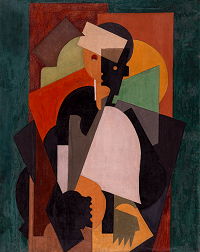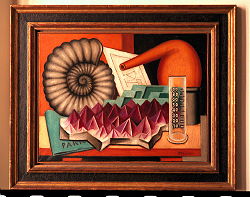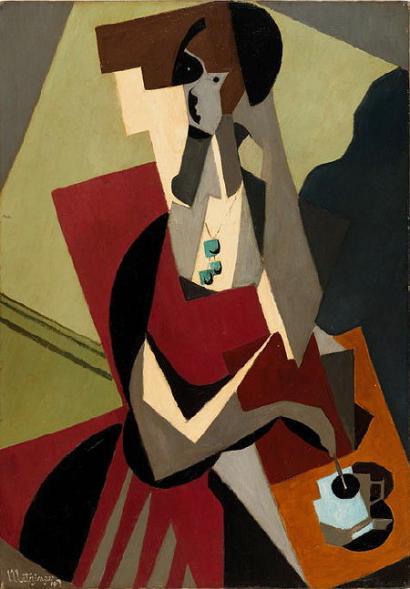The Adresse Musée de La Poste pays a tribute to the authors of the founding document Du Cubisme, that was determining in the discovery and the spreading of the movement in France and abroad, as well as to these two painters who remain today unfairly ill-known in spite of being admired by Apollinaire, André Salmon and a few others. Jean Metzinger, in particular, has never being exhibited in Europe since his death in 1956, which adds to the unique character of this event. What is also unique is the fact a museum shows them, for the first time, together.
 Albert Gleizes, L’Ecolier, 1920, gouache and tempera on canvas, 92x 73 cm. Musée Cantini Marseille © Photo Jean Bernard.
The exhibition includes over 80 paintings and drawings, documents, films and some fifteen works by their friends who took part in the Cubist adventure, all organized in three main sections. The first presents a choice of works by Gleizes and Metzinger done before 1911. The second section, aside from their own works, groups creations by artists from the group of Puteaux and the Section d'Or: Villon, Duchamp-Villon, Kupka, Le Fauconnier, Lhote, La Fresnaye, Valensi, Survage, Herbin, Marcoussis, Archipenko… thus showing the diversity of the Cubist movement, born in 1907 in Picasso’s workshop. Last but not least, the third section shows the aesthetic itineraries followed by the two artists after 1914. Apparently, everything opposes these two artists, their social positions, their itineraries and their way of life.
The self-taught man and the learned artist
For one, Albert Gleizes is a self-taught painter. He created his first paintings in 1901, visited the Impressionist exhibitions and read the Symbolist writers under the advice of the poet René Arcos. Very quickly he abandoned his Impressionist-style landscapes and dedicated himself, totally free, to drawing and to showing the life of the sailors, the banks of the Seine, the markets of Bagnères-de-Bigorre… In 1909 he met Henri Le Fauconnier and this encounter was determining and oriented his new aesthetic choice. The other, Jean Metzinger, studied art and as of 1903 regularly exhibited his Neo-Impressionist and Fauve works. Thanks to Max Jacob and Apollinaire, he developed a passion in his discoveries of Picasso and Braque, whom he met at the Bateau-Lavoir. Apollinaire did not hesitate to say these three painters – on their own – made up the “Cubist town”. Gleizes and Metzinger met in 1910. From that moment on they never left each other, confronted their works, their positions that at times differed, and mostly they worked together to have Cubism be known by the greatest number.
 Jean Metzinger, Améthyste et coquillage, 1927, oil on canvas, 45 x 61 cm. Private collection, Spain.
After the war the two artists followed totally different ways. In 1919, upon his return from the U.S.A. – of which he always had mixed memories - Gleizes pursued the Cubist adventure and never stopped making it evolve. As of 1915 he made a few non-figurative works that already integrated vertical and oblique plans; later he developed circular movements, giving birth to a pictorial system based on rhythm, the rotation and the translation of plans. Little by little Metzinger stepped away from Cubism. As of 1922, he returned progressively to figuration. In search for the built form he carried out a series of works that owe everything to geometry but in which he combined different aesthetics. In the 40s and 50s he came back to the way he practiced Cubism in his beginnings, imitating himself and making it difficult sometimes to date his works. While Gleizes left an impressive bibliography including articles, works, conferences, philosophical thoughts… Metzinger abandoned writing on art and dedicated himself to poetry.
To see more illustrations, click on VERSION FRANCAISE at the top
of this page
• PUBLICATION:
Bilingual catalogue (French-English), co-edited with the École nationale des beaux-arts de Paris, €20.
|










